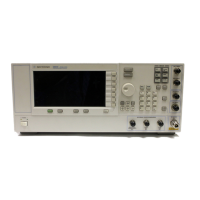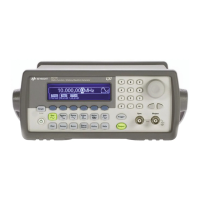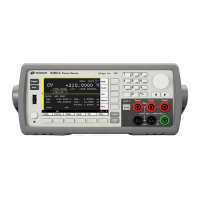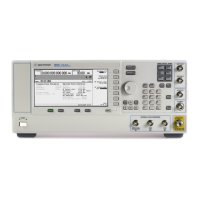E8257D/67D, E8663D PSG Signal Generators Service Guide 147
Troubleshooting
Reference/Synthesis Loop Description
Reference/Synthesis Loop Description
This description covers generating CW and swept signals at frequencies from
3.2 to 10 GHz. For information on generating other frequencies, see the
“Overall Description” on page 134.
The Reference/Synthesis Loop establishes the frequency characteristics of the
signal generator. Frequency requirements include the following:
— fundamental frequency range generation
— phase noise
— frequency accuracy
— sweep rate (in sweep mode, Option 007)
— swept frequency accuracy (in ramp sweep mode, Option 007)
Reference/Synthe
sis Loop
Hard ware
In CW operation, the hardware used includes the A7 Reference, A5 Sampler,
A6 Frac–N, A7 Reference, A9 YIG Driver, A28 YIG Oscillator (YO), and A29
20 GHz Doubler.
In sweep mode, the A5 Sampler is not used.
CW Mode The following two basic functions are used to generate an accurate frequency:
— coarse and fine tuning
The Pre–tune DACs on the A9 YIG Driver provide coarse tuning; the A5
Sampler and A6 Frac–N assembly provide fine–tuning.
— frequency monitoring or feedback
Example (5 GHz CW)
The A18 CPU sets the A9 YIG Driver Pre–tune DAC to a value such that the YIG
oscillator output is approximately 5 GHz (within approximately 3 MHz of the set
frequency). The A18 CPU also sets the A5 Sampler VCO and the A6 Frac–N
VCO frequencies to the values necessary to generate a 5 GHz YIG Oscillator
output.
The A29 20 GHz Doubler receives the output of the YIG oscillator, and couples
off and routes a portion of the signal to the A5 Sampler.
On the A5 Sampler, the VCO output samples the 5 GHz from the A29 20 GHz
Doubler and converts it to an IF frequency between 30 and 64 MHz. The IF
signal is then filtered and routed to a phase detector.
The output of the VCO on the A6 Frac–N is also routed to the A5 Sampler,
where a divide circuit generates the phase detector reference frequency.
At this point, the reference IF and the sampled IF are approximately at the
same frequency/phase. When the two signals are in phase, the output of the
phase comparator is 0 volts. If the two signals are not in phase, the phase
detector generates a voltage proportional to the phase (frequency) difference
or error.

